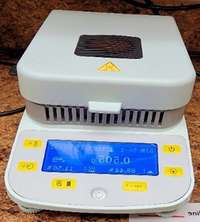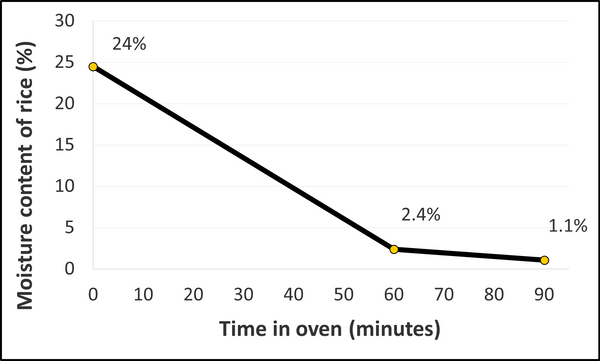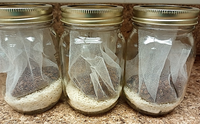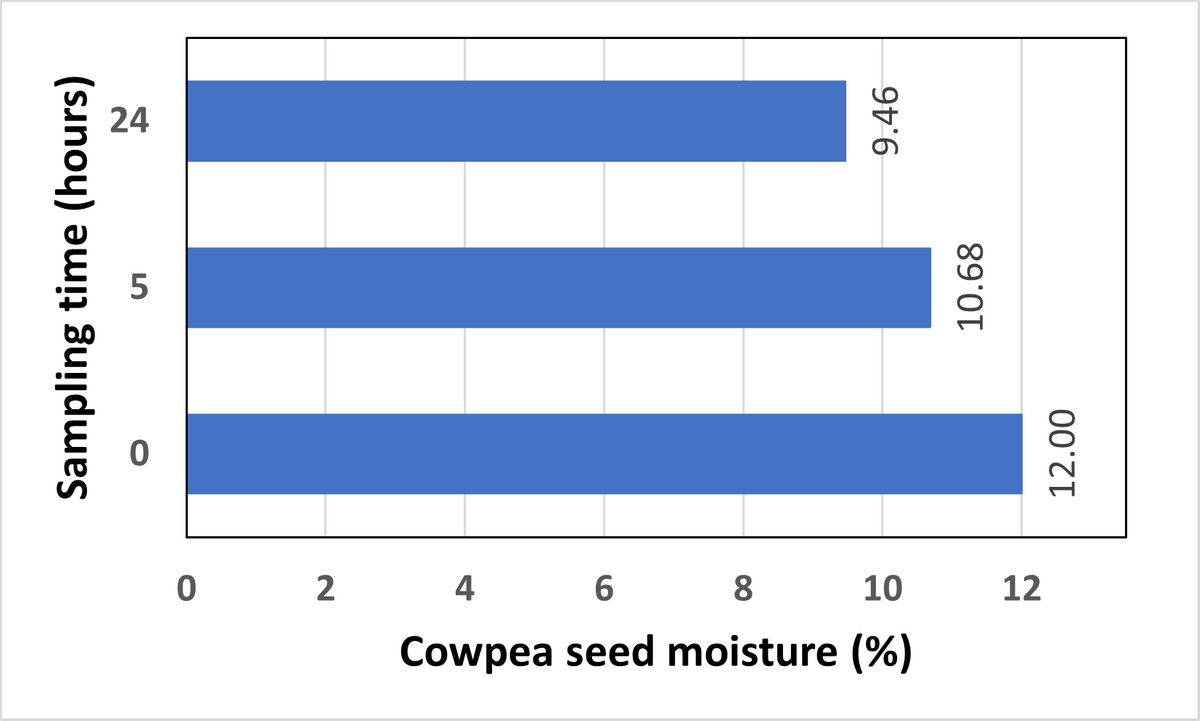Introduction
Seed preservation is an effective tool to promote agrobiodiversity. Seed preservation also increases the cultivation of local plant species better adapted to specific areas, enhances genetic variability in pollinated species, and preserves food security. Seed preservation saves farmers money and improves their chances of increasing crop yields (Montúfar and Ayala, 2019).
How to dry seeds
Seed drying is the most vital step in the seed preservation process. How quickly and effectively seeds are dried affects germination rates and seed viability (Harrington, 1959; Saipari et al., 1998). Most seed preservation practices are not new (Weisdorf, 2005; Blakemore, 2019). Seed preservation options evolved over centuries of trial and error, indigenous knowledge, and advances in agricultural technologies (Matsa and Mukoni, 2013; Shaila and Begum, 2021).
Methods to dry seeds include hanging seeds from trees, solar drying, desiccant drying, simple local driers, drying seeds on tarps, curing tables, and using wood ash (Chua and Chou, 2003). These practices vary based on culture, climate, and crop. For example, in Ghana, maize (Zea mays) seeds are picked at the first of harvest by the color and size and then dried on the cob near stoves in woven bags to reduce pest problems. In Malawi, women pick the seeds from the cob throughout the harvest season based on the maize size. Seeds are placed near the stove but may also be hung from the trees (Wright and Tyler, 1994).
Rice as a desiccant
We have known for centuries that rice absorbs water at high temperatures. In fact, we all use this principle when we cook rice. However there has been a growing interest in using rice as a desiccant. One study focused on using rice to dry out hearing aid devices (Nelson et al., 2017).
Sadik and White (1982) experimented with rice as a desiccant to dry seeds for long-term storage. They found that 30 to 40 g of toasted rice (with < 1% moisture) dried 20 g of true potato seed from 11.5% moisture down to 4 to 5% moisture. They also found that toasted rice had more drying capacity than toasted kernels of wheat, maize, or soybean.
There is, therefore, support in the literature for using rice to dry seeds. We wanted to determine if rice serves as a suitable desiccant to dry freshly harvested cowpea (Vigna unguiculata) seeds, as well as to find out if it is feasible to dry cowpea seeds with reheated rice that has already been used as a desiccant.
ECHO trials using oven-dried rice
Can you remove moisture from rice in an oven?

Figure 9. Meter used to determine the moisture of rice kernels and cowpea seeds. Source: Guinevere Perry
We used store-purchased, long-grained white rice. The rice was not washed. Prior experience at ECHO and work by Sadik and White (1982) indicates that the drying capacity of rice is enhanced by pre-heating, to remove existing moisture out of the grain before using it as a desiccant. In our study, we heated the rice in a drying oven for 1 and 1.5 hours at 135°C. The rice displayed a visible change in appearance, becoming a light golden color in appearance that was most noticeable after 1.5 hours.

Figure 10. Moisture content of rice kernels after 0, 60, and 90 minutes of oven-drying at 135°C.
We tested rice moisture content before and after heating using the device pictured in figure 9. Initial rice moisture content was over 24% (Figure 10). The heating process removed a significant amount of moisture from the rice, drying it to 2.4% moisture after 1 hour of heating.
Can oven-dried rice remove moisture from freshly harvested cowpeas?

Figure 11. Cowpea seeds being dried with oven-dried rice. Source: Guinevere Perry
We placed the oven-dried rice in the bottom of glass jars (500 ml volume). We moistened cowpea seeds in Ziplock® bags with water to achieve an initial moisture content of 12%, simulating a level of moisture that may be present at harvest. Then, we placed the rehydrated cowpea seeds in mesh cloth directly above the rice (at a 2:1 ratio [60 g oven-dried rice:30 g cowpea seeds]) as shown in figure 11. We collected samples of cowpea seeds at each of two sampling times, 5 and 24 hours, to measure cowpea seed moisture. This was done for rice that had been oven-dried at 135°C for 1 and 1.5 hours. Results were comparable for the two drying times. Figures 12 and 13 show data obtained with rice that was oven-dried for 1 hour.
After 5 hours, the oven-dried rice (for 1 hour at 135°C) reduced the moisture content of cowpea seeds from 12% to 10.68%, a 1.32% drop in moisture (Figure 12). After 24 hours, cowpea moisture declined to 9.46%. Thus, the rice reduced cowpea seed moisture content by over 2.5% within 24 hours.

Figure 12. Cowpea seed moisture (%) with 0, 5, and 24 hours of drying in a sealed jar with rice that had been heated for 1 hour. Data shows the average of two replicates.

Figure 13. Moisture (%) removed from cowpea seeds dried with new rice (heated at 135°C for 1 hour) and used rice (re-heated at 135°C for 30 minutes). Data shows the average of two replicates.
Can oven-dried rice be reused as a desiccant?
We collected the rice from each of the glass jars, and reheated the rice in the oven at 135°C for 30 min. We watched closely to make sure the rice did not burn. The reheating process reduced the moisture content of rice to around 0.55%. We placed the reheated rice back into glass jars with a fresh set of cowpea seeds for 24 hours. Initial moisture content of the fresh cowpea seeds was 11.8%. Upon removal from the jars, results shown in figure 13 suggest that rice can be reheated and still act as a desiccant to dry out seeds.
We observed something interesting from rice initially dried for 1.5 hours (data not shown). The amount of moisture removed from cowpea seeds was 0.54% less with the reuse of rice initially heated (at 135°C) for 1.5 hours than for 1 hour. Perhaps the additional heating time made the rice more brittle and less able to absorb moisture. The finding suggests that heating should be done in such a way as to minimize darkening (indicative of potential burning) of the rice while heating. This could be confirmed with additional research.
Conclusion
The study suggests 1 hour of heating suffices to make rice an effective seed-drying desiccant.
Pre-heated rice, both new and used, proved capable of drying cowpea seeds to a moisture content of less than 10% (a good value for long-term seed storage); this happened within 24 hours in this study with an initial cowpea moisture content around 12%. Longer drying times may be needed for newly harvested seeds that have higher moisture content. More research is needed to find out if rice can be re-used more than once. See an ECHO Development Note article entitled “Are my seeds dry enough [http://edn.link/salttest]?” (Reader and Motis, 2017) for information on ways to determine seed moisture even if you do not have a moisture meter. Let us know of your experience using rice as a desiccant.
References
Blakemore, E. 2019. What was the Neolithic revolution. National Geographic, 5.
Chua, K. J. and S.K. Chou. 2003. Low-cost drying methods for developing countries. Trends in Food Science & Technology, 14(12), 519-528.
Harrington, J. F. 1959. Drying, storage, and packaging seed to maintain germination and vigor. Seed Technology Papers. 44.
Matsa, W. and M. Mukoni. 2013. Traditional science of seed and crop yield preservation: exploring the contributions of women to indigenous knowledge systems in Zimbabwe. International Journal of Humanities and Social Sciences. 3(4)
Montúfar, R. and M. Ayala. 2019. Perceptions of agrodiversity and seed-saving practices in the northern Andes of Ecuador. Journal of ethnobiology and ethnomedicine, 15(1), 1-25.
Nelson, L. H., K.R. White, D.V. Baker, A. Hayden, and S. Bird. 2017. The effectiveness of commercial desiccants and uncooked rice in removing moisture from hearing aids. International Journal of Audiology, 56(4), 226-232.
Reader, S., and T. Motis. 2017. Are my seeds dry enough? ECHO Development Note no. 136.
Saipari, E., A.M. Goswami, and M. Dadlani. 1998. Effect of seed drying on germination behavior in citrus. Scientia Horticulturae, 73(2-3), 185-190.
Sadik, S. and J.W. White. 1982. True potato seed drying over rice. Potato Research, 25, 269-272.
Shaila, M. and N. Begum. 2021. Ancient farming methods of seed storage and pest management practices in India—A Review. Plant Arch, 21, 499-509.
Weisdorf, J. L. 2005. From foraging to farming explaining the Neolithic Revolution. Journal of Economic surveys, 19(4), 561-586.
Wright, M. and P. Tyler. 1994. Traditional seed-saving practices in northern Ghana and central Malawi. Chatham: Natural Resources Institute.
Additional recommended resources:
Bicksler, A. 2014. The importance and biology of seed saving. [A presentation at the 2014 ECHO Asia Seed Banking Workshop] http://edn.link/d24w4p
ECHO Staff. 2016. Seed storage in the tropics. ECHO Best Practice Note no. 5. http://edn.link/bpn5
Motis, T. 2010. Seed Saving Steps and Technologies. ECHO Technical Note no. 63. http://edn.link/tn63
Thompson, K. 2016. Seed saving in the tropics: Lessons learned from the network. ECHO Asia Note no. 28. http://edn.link/49fyja